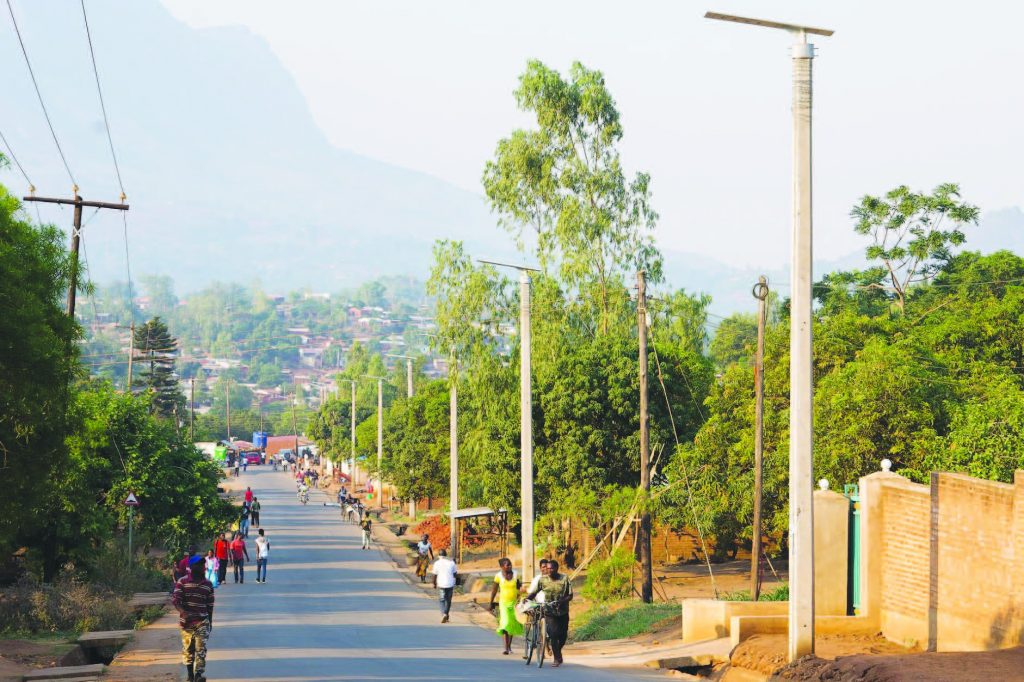Cities get solar streetlights
For 20 years, Grace Nduli, 50, has been selling tomatoes, onions and cassava at Zomba Central Market.
Until 2017, the vendor used to knock off before sunset, afraid of being robbed on the way home in Chikanda Township.

“But that is history. Following the installation of solar-powered streetlights in the city, we now work till late and walk home without fear,” she says.
The mother of five commends Zomba City Council (ZCC) for the lights, which have improved security and quality of life.
But streetlights are not cheap when powered from the national grid.
Solar energy works
Zomba was the first city in Malawi to get solar-powered streetlights. The switch to solar energy has reduced electricity bills for street lighting.
“Cities require effective streetlights to enhance the security and the socio-economic status of citizens,” says ZCC chief executive officer Charles Thombozi.
He is happy that businesspeople no longer flee darkness, but trade till late in the night.
ZCC first installed solar lights on the M3 along the city’s boundaries. It has installed 867 solar-powered streetlights in three phases, starting with the road from Four Miles to Chikupira.
“There were no lights on this road [from Blantyre to Zomba]. Right now, we are extending streetlights to residential areas and trading centres,” Thombozi says.
The solar lights automatically switch on when darkness falls and off at daybreak.
“When there are no vehicles or people under the street poles, the light is weaker, but becomes stronger when they detect a moving object,” the ZCC chief explains.
The council has waved goodbye to Electricity Supply Corporation of Malawi (Escom) bills.
“Streetlights become too expensive for councils when Escom bills them as commercial. This leads to disconnections, keeping the city in the dark,” Thombozi explains.
Solar energy assures the city of 156 000 residents of lit streets even when the national grid experiences an outage.
The solar streetlights project is funded by the Roads Fund Administration, but the council decides how to use the annual disbursements and closely monitors the poles to swiftly detect faults and vandalism.
“We encourage residents to report vandals, not to shield vandals,” Thombozi says.
The lights have shattered doubts that solar energy is unreliable during rainy and chilly seasons.
Road users do not experience major changes in light intensity during bad weather because the streetlights store power.
The system shows how clean energy reduces pressure on on-off grid power, which reaches just about 12 percent of the population amid frequent load shedding.
“Malawi has all the natural resources needed for enhanced use of clean energy, but the challenge is that we are hesitant to embrace clean technology,” Thombozi observes.
The council has upgraded from 70-watts lights in the first phase to 120 watts in the second and 150 in the third. The new lights are brighter and more reliable.
Lilongwe’s turn
The sparkle of Zomba’s success story has attracted admirers in Lilongwe, the capital city, and the evergreen Mzuzu, after decades of struggling to pay Escom bills.
“The council recorded high energy consumption resulting in high monthly bills,” says Lilongwe City Council (LCC) CEO John Chome.
The councils incur additional fees for new connections and cost of cables and trenches.
Chome says the spending for solar streetlights is lower.
“They do not require regular maintenance and replacement,” he says. “Besides, Escom-powered lights have a shorter lifespan than solar lights,” he explains.
Lilongwe switched to solar streetlights in January 2019. The off-grid solution has liberated the council from power cuts.
“The streets remain lit even with frequent blackouts or faults affecting the national grid,” Chome says.”
They are simple to operate and pose no threat to the environment, he states.
“They start functioning the same day they are installed,” he says.
LCC has erected solar streetlights on the Presidential Drive from Parliament Roundabout to Bingu Stadium, Mphonongo Street in Area 43, Chendawaka Street, Ufulu Road and Mzimba Street-Central Hospital.
Mzuzu’s story
Similarly, Mzuzu City Council (MCC), which rations streetlights to reduce electricity bills, is migrating from hydropower.
The city’s CEO Gomezgani Nyasulu says all roads earmarked for upgrading are designed to have solar power.
“The high cost of maintaining hydro-powered streetlights is the reason we are switching to solar power,” he explains. “The council fails to provide vital services due to high electricity bills.”
Nyasulyu is concerned that MCC could only light the streets during essential activities or just a few streets.
“The council needs about K4 million to light the streets for a month. This isn’t sustainable,” he says.
Solar lighting will cover 20 kilometres from Mzuzu central business district to Katawa, Kaning’ina, Chimaliro, Masasa SOS, Mchengautuwa, Luwinga, Chiputula, Zolozolo and Katoto townships in the vicinity.
At night, the Orton Chirwa Avenue, Mzuzu Bus Station and Civic Offices glow with the desired, self-operated lights valued at K36 million.





